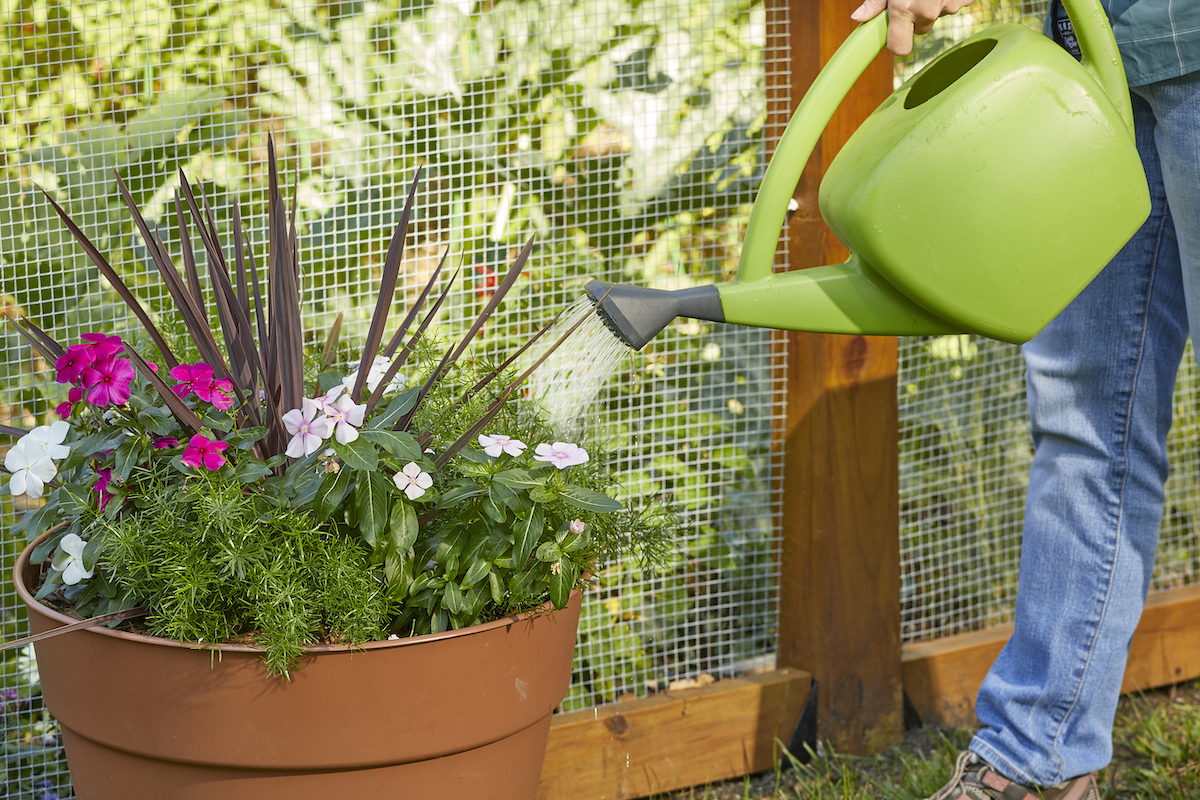

We may earn revenue from the products available on this page and participate in affiliate programs. Learn More ›
No matter what color your thumb, you likely already know that all plants need water to reach their full potential—after all, that basic knowledge goes back to introductory middle-school science class. But what you might not know is that incorrect plant watering techniques can put plants at risk for disease and even kill them. Whether you want to cultivate pretty outdoor perennials or you just bought a new houseplant, heed these best and worst practices for watering plants indoors and out and you’ll reap healthy, happy specimens.
Watering Outdoor Plants
1. DO hydrate plants in the morning.
The best time of day to water plants is in the morning, says Peter Pappas, an irrigation system designer in Middlesex County, Massachusetts. “Water outdoor plants early in the morning to reduce evaporation,” he says. The cool soils affords the water the best chance of reaching the roots of the plants before evaporating. Watering plants early will ensure that they have sufficient store of moisture beneath the soil to withstand the heat of a hot summer day. The worst time to water garden plants? At night. If you water flowers and vegetables after the sun goes down, fungi can take hold.
2. DON’T water too frequently.
Before watering, check that the soil is supple and not too wet. Especially during hot weather, it may be tempting to water just enough—and often enough—to keep the soil damp. Shallow surface garden watering, however, discourages deep root development. Instead, opt for a less-frequent watering routine that thoroughly saturates the soil. “Deeply water to promote strong root growth,” Pappas says, and to encourage “deeper, more resilient root systems.” Most plants prefer evenly moist soil, but the ideal moisture level depends on the plant species and stage of growth. The standard rule of thumb is to give your flowers and vegetables the equivalent of 1 inch of water per week (and as much as double that amount in the peak of summer). “Stop (watering) when the soil is moist but not waterlogged,” Pappas adds.
3. DO water plants at soil level.
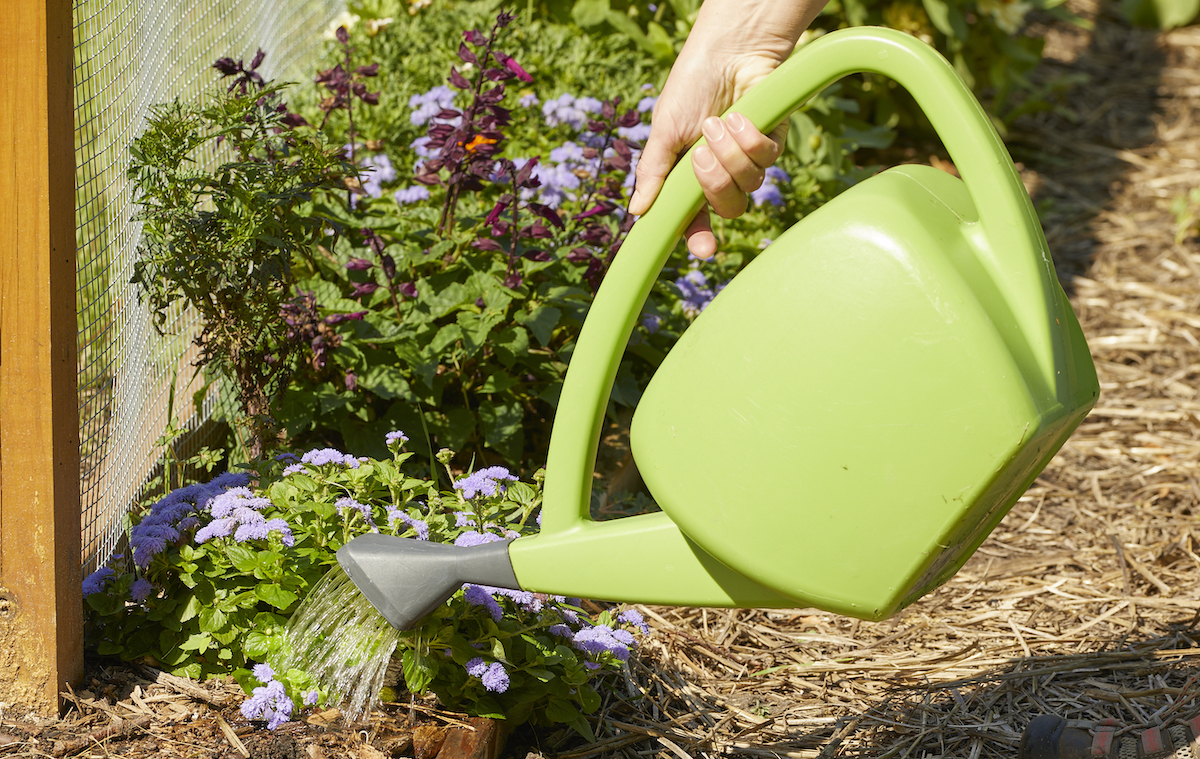
Directing water at the base of your plants delivers the hydration right where it’s needed: the roots. Consider winding a soaker hose between plants in a flower or vegetable bed to soak the soil slowly and deeply and ensure healthy growth. Water slowly so the water can soak into the soil surrounding the plants and be available to the roots, as opposed to just running off. (Don’t have a soaker hose yet? Check out Bob Vila’s tested guide to the best soaker hoses for our top recommendations.)
4. DON’T use broadcast sprinklers.
In addition to soaking the plant’s leaves, which can increase the risk of a fungal disease, broadcast sprinklers are simply inefficient. On a hot or windy day, much of the water distributed by this type of automatic plant watering system can evaporate or blow away before it even reaches the plant and less water goes to the base of the plant.
5. DO water outdoor container plants at least once per day.
Soil in container gardens and flowerpots dries out more quickly than soil in a garden plot or flower bed. The smaller the container, the more frequently you need to water, but be sure to “drain excess water from the bottom of pots to prevent waterlogging,” says Matthew Wilson of Handy Gardeners. Soak the soil in containers in the morning, and, if the mercury in the thermometer climbs to 90 or above, give them another soaking in the afternoon. Alternatively, insert an automatic plant waterer that features a hollow spike and attaches to a standard plastic water bottle. When the spike is inserted in the pot, water slowly seeps into the soil, offering the plant a steady supply of water.
6. DON’T forget that trees need water, too.
Newly planted trees and shrubs should be thoroughly soaked with water 2 or 3 times per week for the first month. After that period, water weekly during their first growing season. Established trees and shrubs (which are at least 2 years old) only need to be watered once every 2 weeks during the growing season when rain is scarce.
7. DO use a wand to water container plants.
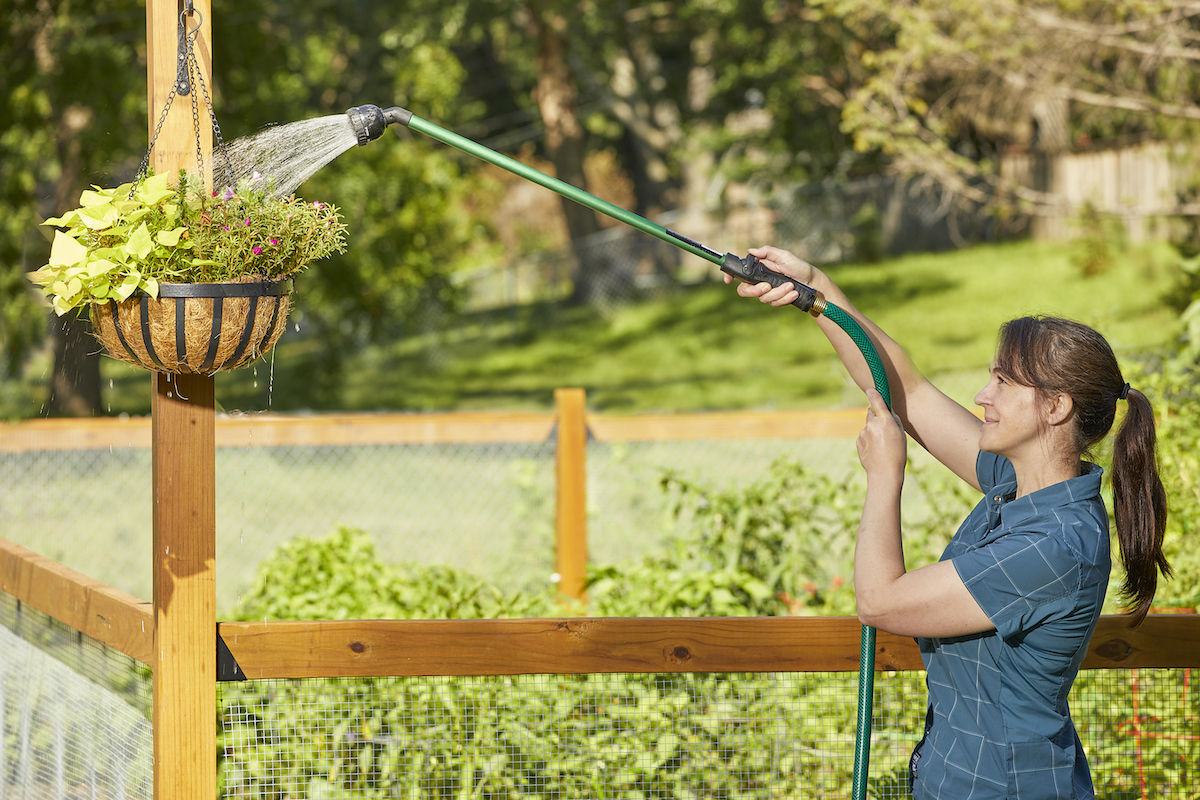
A watering wand extends the reach of your arm, allowing you to direct water at soil level in overhead hanging plants and in short, ground-level flower pots on the ground without having to stretch or stoop. You’ll conserve water by directing only the amount needed to the base of the plant and you’ll save your back.
8. DON’T water container plants with a jet-type spray nozzle.
Pressurized nozzles are great for washing off driveways and sidewalks, but the spray that they deliver can damage tender foliage and blossoms. It can also disturb the soil around the roots of a container plant. If you don’t have a watering wand, just remove the nozzle from the garden hose, hook the hose into the hanging pot or container, and let the water run out slowly.
9. DO check moisture levels.
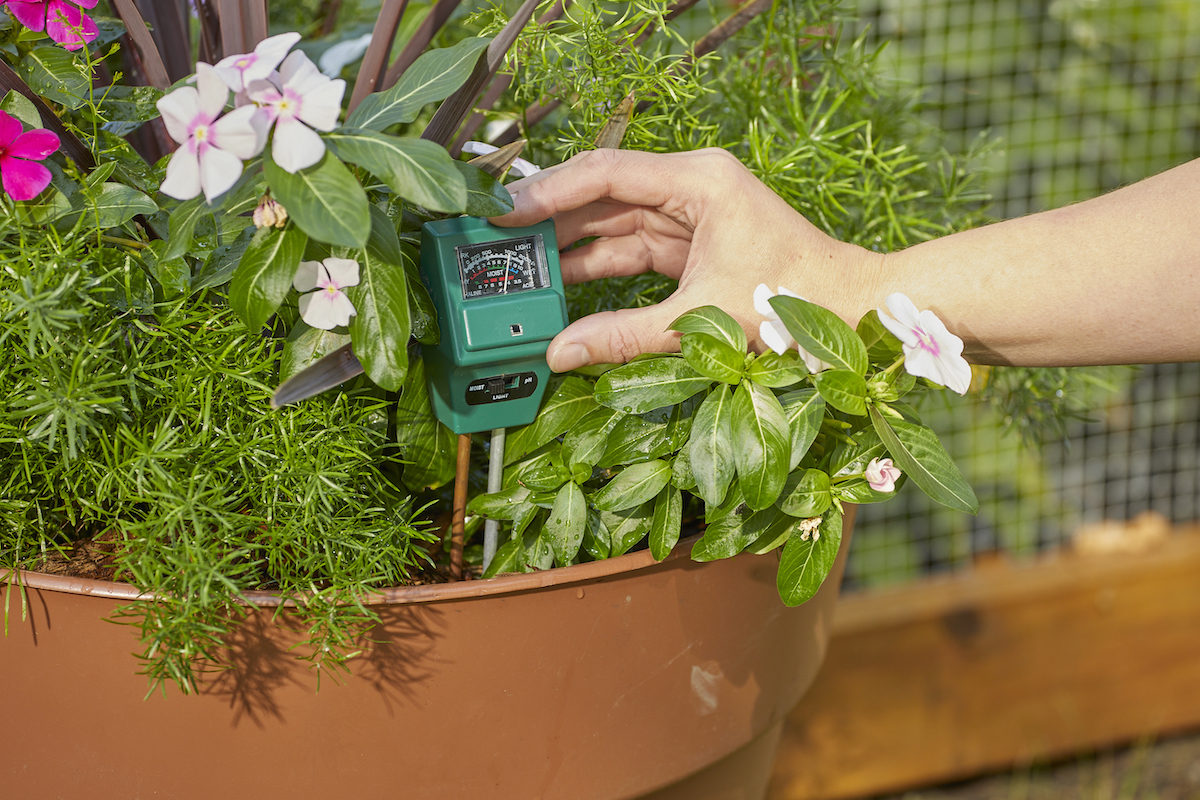
Garden plants can suffer when the soil dries out. “Most plants can go for a few days up to a week without water,” says Wilson. “However, it is important to monitor them and make adjustments to their water.” Plants don’t like “wet feet,” meaning they also suffer if their roots are sitting in water and not getting sufficient oxygen.
On a hot, windy day, the soil’s surface may appear dry, while the ground beneath is still moist, so it’s essential to perform a quick check to ensure you don’t overwater. Keep a wooden dowel handy and insert it a few inches into the garden soil and then pull it out and check it. Moist soil will stick to the dowel, but if it comes out clean, the soil is dry, and it’s time to water. A soil moisture meter can give you an even more accurate idea of your soil’s water needs.
10. DON’T rely on rain.
Most garden plants, flowers, and shrubs do best when they receive at least 1 inch of water per week, although they may need more during hot, dry spells. Rain isn’t always sufficient for plants to thrive, so don’t count on it to keep plants healthy. Instead, keep a rain gauge in the garden to monitor weekly rainfall. If your garden gets less than 1 inch of rain, supplement by watering. If you have a way to harvest rainwater and use it for irrigation during dry spells, this is ideal.
Watering Indoor Plants
11. DO use a watering can for houseplants.
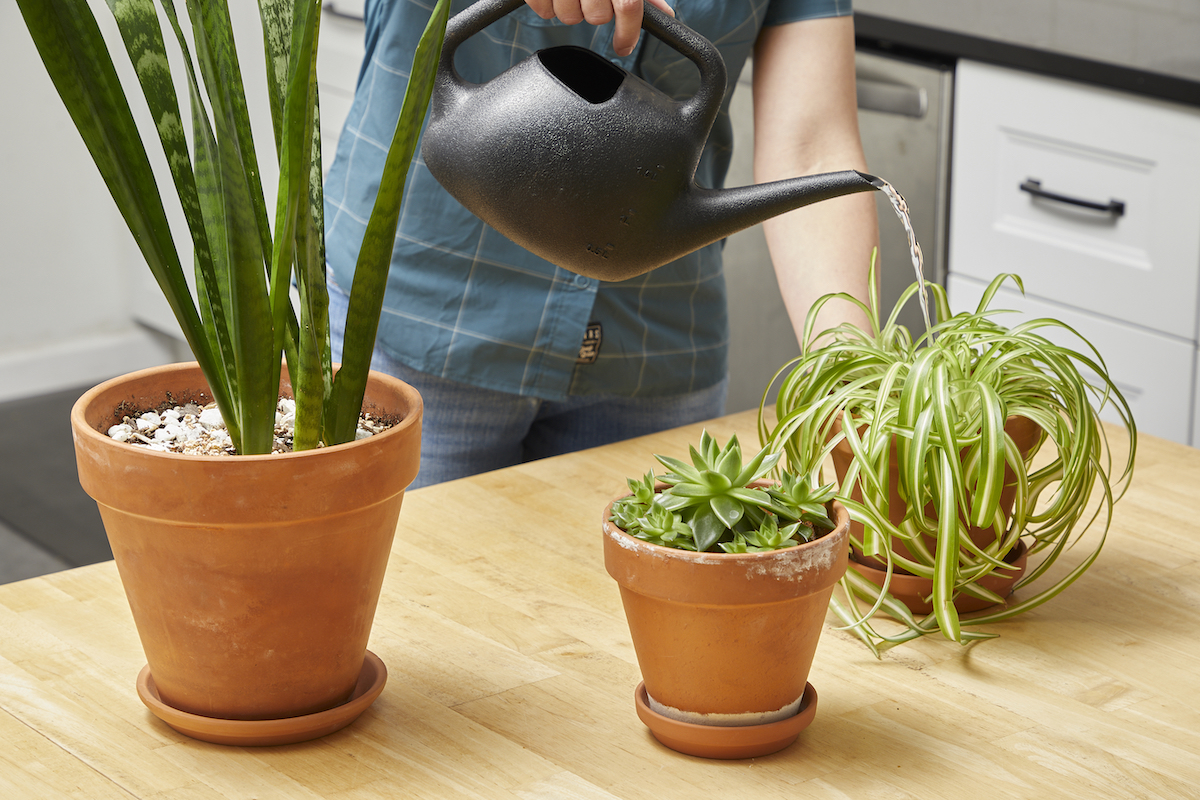
Trying to water a leafy houseplant from a drinking glass or carafe is just asking for water to spill out over the rim and onto your table or windowsill. “Use a watering can with a narrow spout that can water directly into the soil at the base of the plant without wetting the foliage,” says Wilson. A watering can’s long spout also eliminates spills.
12. DON’T water houseplants with treated softened water.
Home water softeners impart sodium into your tap water, which, over time, can negatively affect the mineral makeup of a houseplant’s soil. Depending on your plumbing, your water softener may connect only to the hot water faucets or to all the faucets in your home, both hot and cold. If it’s the latter (or you aren’t sure), stick to filling your watering can at an outdoor spigot to minimize the amount of sodium you introduce to the soil.
13. DO choose the right potting soil.

Houseplants will benefit from an indoor potting mix that’s made for the particular type of plant being grown. Avoid filling indoor pots with outdoor garden soil, which can contain pathogens, insects, and fungi that result in plant diseases and can even fill the house with an infestation of gnats. Instead, opt for a soilless houseplant mix that contains a mixture of peat moss and perlite or vermiculite. These mixes won’t pack down so roots can reach deep, and they often come with fertilizer to boost plant growth.
Pro Tip: When planning your landscape, consider grouping plants with a similar watering regime together so that the watering routine is easier, suggests Mathew Wilson. This way, he says, “Every plant in the group is watered with an appropriate amount of water.”
14. DON’T use a potting mix that’s overly water-retentive.
Most houseplants need a potting mix that drains well and doesn’t remain soggy for hours (or days) after watering. When shopping for an indoor, houseplant potting mix, look for products that contain either coconut coir, vermiculite, or perlite. All three ingredients are used in potting mixes to help aerate the soil and encourage draining. For the best draining, use a potting mix that does not contain more than 1 part peat moss.
15. DO check a soil moisture gauge.
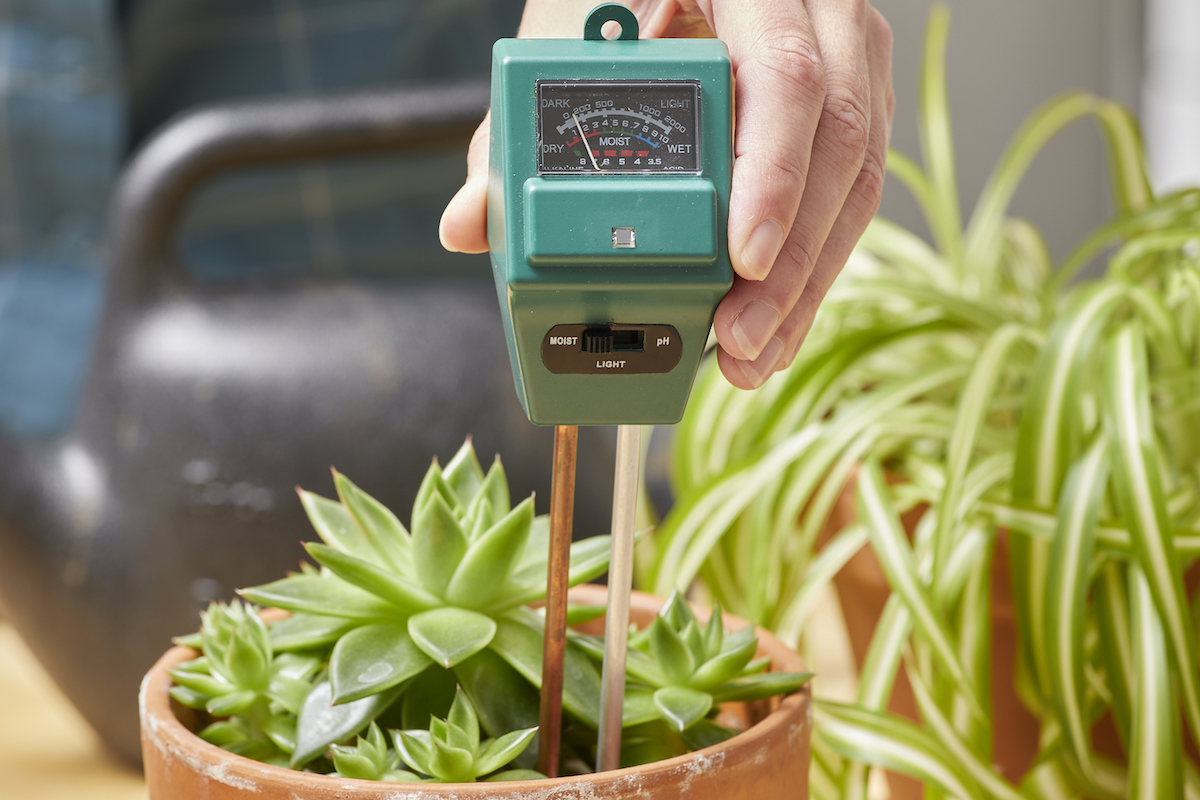
A soil moisture gauge costs less than $20 and you can insert it directly into the soil to find out whether it’s dry, moist, or wet as many as several inches deep by the roots. Large houseplants in small pots absorb water more quickly than small plants in large pots. When you use a moisture gauge, as opposed to following a watering schedule, your plants will get the water they need, when they need it.
16. DON’T put houseplants in pots without drainage holes.
Most houseplants need well-drained soil in order to grow and thrive. If water cannot drain out through the bottom of the pot, the roots are subject to sitting in water and potentially rotting. Check the bottom of each potted houseplant and repot those in pots without drainage holes into more appropriate containers that do have holes.
17. DO water less in winter and more in spring.
During winter, the days are shorter and indoor houseplants receive less ambient light through windows. As a result, photosynthesis (the process in which a plant turns light into food) slows and the plant enters a resting phase, during which it needs less water. As spring approaches, however, longer days signal the plant to start growing, and at this time, its water needs increase. Adjust your habits for watering plants accordingly so as not to cause distress or thirst.
18. DON’T forget to dump the water collection tray.
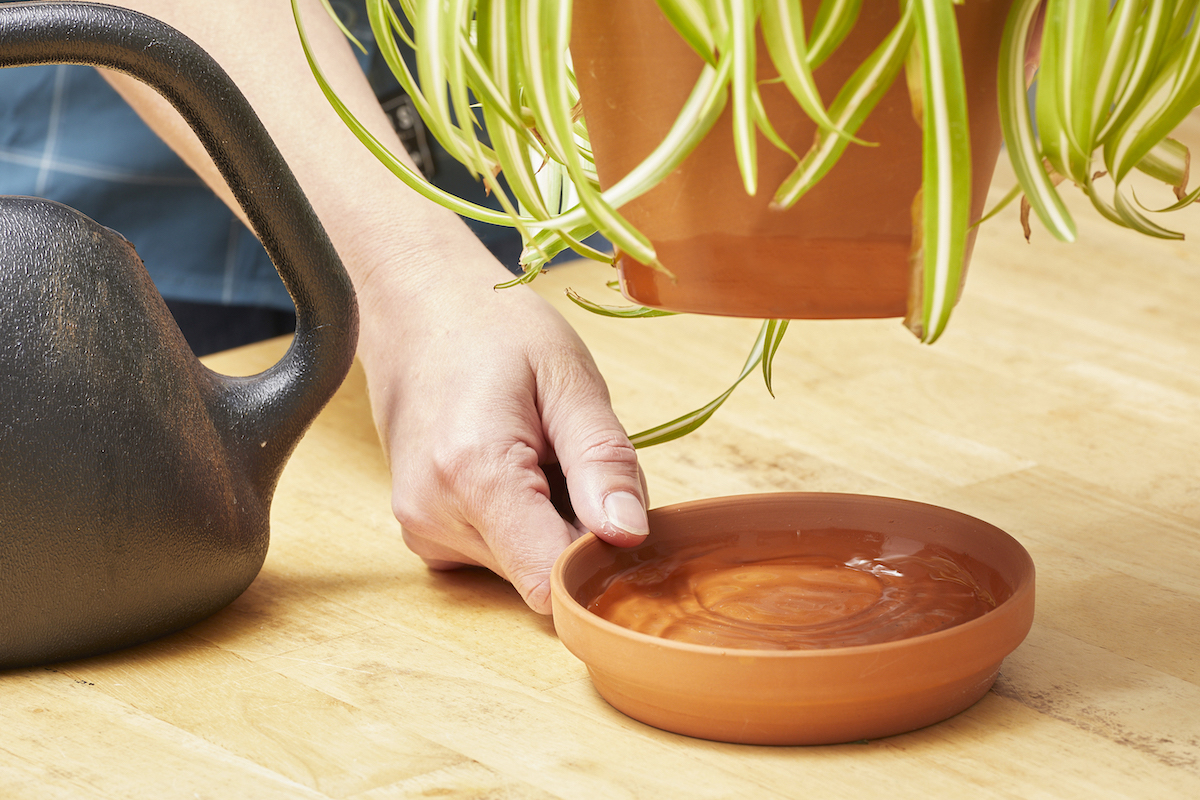
When watering, excess H2O will drain into the collection tray beneath your houseplant almost immediately, but don’t pour it right away—the plant may reabsorb some of it within the next 30 minutes. After that, go ahead and dump it. Allowing a plant to sit in standing water increases the risk of root rot, a potentially deadly development for the plant. You could also try bottom watering plants, where you add water only to the collection tray and allow the soil and roots to suck up water from the bottom of the pot.
19. DO wick while you’re away.

Even the healthiest houseplants will suffer from not being watered for a week or two when the family goes on vacation. Avoid setting them in the tub or sink filled with a couple of inches of water, or they could perish from wet feet.
Wicking is a simple way of ensuring the plant gets enough water without flooding it:
- Place a large jar of water next to the plant.
- Cut a section of cotton rope or even a strip of absorbent fabric long enough to reach from the plant to the bottom of the water jar.
- Poke one end into the top of the soil and insert the other in the water jar. The rope acts as a wick to slowly transfer water to the plant while you’re away.
20. DON’T overwater.
Overwatering is one of the main causes of houseplant failure. Houseplant newbies have a tendency to water their greenery too often, thinking that’s just what they need. Overwatering increases the risk of root rot and fungal disease. If you see droopy stems, wilting leaves, a whitish coating (fungus), or fungus gnats—pests that thrive on consistently wet soil—in the home, it’s a good bet that you’re watering plants too much.
On the other hand, when the bottom leaves on your houseplant dry out and drop and edges of the leaves elsewhere on the plant become crisp and brown, it’s probably not getting enough water. Using a soil moisture gauge will help you find that happy medium.
Final Thoughts
In addition to light and oxygen, plants need water to thrive. Good watering practices will result in healthy plants—both indoors and out—that add a verdant touch to a home’s décor or landscaping. Regular watering is also essential for producing healthy fruits and vegetables in the garden.
FAQs
“Look for yellowing leaves, wilting despite wet soil, and general poor growth,” says Pappas. Over time, soil that remains too wet leads to root rot, he adds. “Ensure good drainage and allow soil to dry out between waterings.”
Many plants have differing irrigation requirements, but in general, water once or twice per week, using enough water to moisten the soil to a depth of about 6 inches each time. It’s okay if the soil’s surface dries out between waterings, but the soil beneath should remain moist. “Do not water the plant when the soil is already wet,” says Wilson.
Plants don’t need daily watering. Instead, water deeply but less frequently. Deep waterings allow the water to seep beneath the roots, which encourages the roots to grow downward. “Stop watering the plant when the soil is moist but not waterlogged,” says Wilson.
Outdoor plants love rain, but if it doesn’t rain at least 1 inch per week, consider using supplemental irrigation to provide enough moisture for healthy plant growth.
